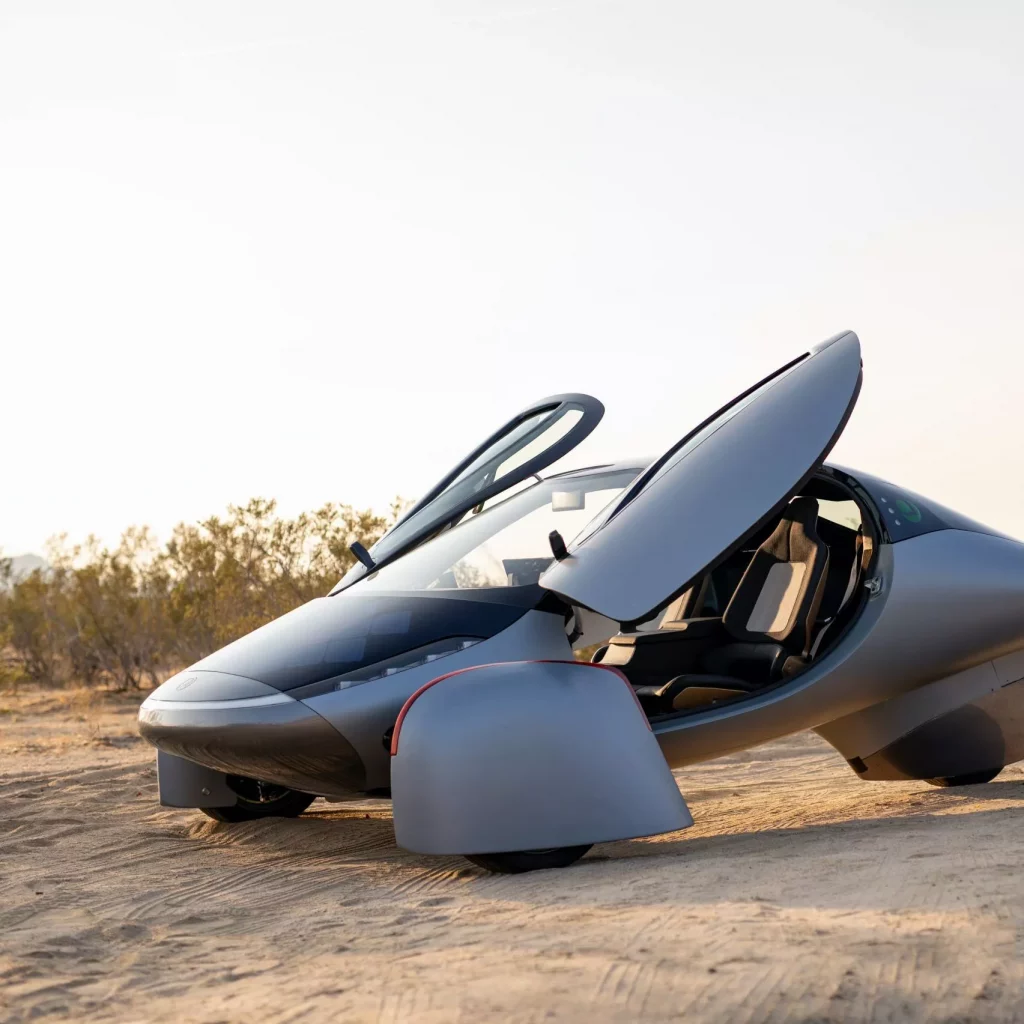In Episode 166 of the Disruptors for Good podcast, I speak with Steve Fambro, Co-CEO of Aptera Motors, on creating the most efficient solar electric vehicle(SEV) on the planet.
Listen to more Causeartist podcasts.
About Steve
Steve Fambro is the Co-CEO of Aptera and a venture partner and COO at Ocean Holding, an environmental-focused developer of clean energy solutions.
He’s also the founder of Famgro – pioneering indoor farming technology that ditches pesticide/herbicide usage in favor of creating super efficient food production systems requiring only $8m to launch.

What is a Solar Electric Vehicle(SEV)?
Solar electric vehicles, also known as SEVs, are vehicles that use solar power to generate electricity. This electricity is then used to power the vehicle’s motor and drivetrain, providing a clean alternative to traditional gasoline-powered vehicles.
How does a Solar Electric Vehicle(SEV) Work?
The key component of an SEV is its photovoltaic cells—or “solar panels”—which capture sunlight and convert it into electricity. This electricity is then stored in the vehicle’s battery for later use.
The battery powers the motor, which in turn propels the car forward. Unlike a conventional gas-powered engine, an SEV never needs to be refueled; all it needs is sunlight.
About Aptera
Aptera is empowering the next generation to lead a more sustainable lifestyle with efficient transportation solutions. When driving this solar electric vehicle, you can reduce your daily carbon footprint by 14K pounds of CO2 – and make lasting change through thoughtful resource management.
The EV is revolutionizing transportation by reimagining how vehicles are conceptualized and assembled. With a bold embrace of 3D printing, AI technology, and composite body construction techniques; the company has taken an innovative leap forward in mass-producing efficient automobiles with unparalleled speed and affordability.
The Aptera starts at $25,900.
Let’s take a look at this innovative new car and explore its features.

Aptera Design Features
This solar electric vehicle is a three-wheeled, two-seat car that is powered solely by the sun. The sleek design of this car is perfect for those who want to make a statement while also being environmentally friendly and reducing their carbon footprint.
The most unique feature of the solar electric vehicle is its design. It has three wheels instead of four, and the bodywork is made from lightweight materials such as carbon fiber and Kevlar, making it extremely aerodynamic.
Aptera’s innovative design has revolutionized aesthetics and aerodynamics. Its sleek undercarriage streamlined like a dolphin’s offers reduced drag, allowing for the vehicle to travel more quickly and efficiently than ever before – resembling an aircraft in structure but built for superior speed on roads.
Energy Efficiency
With Aptera, you can get the best of both worlds. Drive up to 40 miles a day with free solar energy or take off on an adventure that lasts for up to 1,000 miles! Get unlimited possibilities and zero emissions today.
Its energy efficiency is due in part to its light weight, as well as its use of regenerative braking which captures energy normally lost during braking and uses it to recharge the battery when you come to a stop.
The Aptera vehicle allows you to go five times farther than other electric vehicles.
Revolutionary Battery System
With Aptera, you can eliminate the worry of finding charging stations. Aptera’s unique diamond shaped solar panels maximize the energy you get from the sun. This gives fully equipped vehicles 700 Watts of continuous charging power — whether you’re driving or parked.
Interview Transcript
00:10
Host: Well, thank you so much, Steve, for joining me today. I’m very excited to talk about Aptera, its mission and vision, and the journey so far. You’re in an inventive space, being one of the first in solar EV vehicles. Before we get into what that exactly means, talk a little about your journey, Aptera’s journey, and how you and your co-founder came up with the first idea and iteration, almost a decade ago.
00:44
Steve Fambro: I guess the way I even determined I had the time to do this and the ability was related to my job at the time. I was a late bloomer, so I didn’t go to university until I was almost 30. I went on the GI Bill and was very mission-focused to get through school. I got hired before I graduated by a biotech company here in San Diego called Illumina.
My girlfriend at the time, who’s also an electrical engineer, and I decided to move to San Diego after graduation. This job was like a dream job.
I was one of the few electrical engineers in the whole company. I had worked as a technician for about 10 years, so I knew how to repair equipment but not design it. The job kept me fully engaged in solving problems related to making DNA. We engineered ourselves out of a job when we built a machine that was thousands of times more efficient. This machine allowed us to produce DNA at virtually no cost, which was necessary for genotyping and other processes.
After that, the engineering team got parceled out within the company, and I got bored. Being a bored engineer is not a good thing. I started working on an electric vehicle project in my garage in 2005. I didn’t have children at the time, so I would spend my days working on this project.
I realized I needed to make this a business, as surely others would want an efficient electric vehicle. I wrote a business plan and did a press release, which led to us getting funded. That’s how we started the first time.
05:27
Host: That was pretty early on in the EV movement. It might have been a little too early; the market wasn’t ready quite yet. Walk us through the first go-around and then the pause before you brought it back with full force. Then, we’ll get into exactly what Aptera is and how it works.
05:51
Steve: Chris and I raised about $40 million at the time. We brought in outside investors and a professional management team with Detroit experience. Around 2008-2009, Chris and I didn’t see eye to eye with the management team, so we left.
Chris started the battery company Flux Power, and I got into vertical farming. I helped manage an ag tech fund for a family office in Abu Dhabi. Chris and I reconnected when my family moved back to the U.S. in 2017. We saw that the ecosystem of suppliers was now in place, and the market had validated the need for electric vehicles.
Tesla had grown into one of the most valuable companies, and we saw people moving more towards electric. We realized our platform could dominate the range equation, which was crucial. That’s when we knew it was the right time to restart Aptera.
07:46
Host: When we talk about solar EVs versus traditional EVs like Tesla, what’s the difference?
08:05
Steve: When we restarted, we noted that some fundamental technologies had improved, like batteries and the efficiency of solar cells. We realized we could cover the roof with these new, efficient solar cells, which would give us around 100 watts. Our vehicle uses about 100 watt-hours per mile, which is a fraction of what other EVs use.
We thought, why not cover the whole vehicle in solar cells? This would give us up to 30-40 miles per day from solar energy alone, which is more than most people drive. The solar cells became an integral part of the design, allowing us to offer a significant amount of free driving from the sun.
This makes us unique in the market, as we’re not constrained by the plug or the grid.
11:12
Host: Not being constrained to the plug is huge. Are the batteries in solar EVs the same as in traditional EVs?
11:47
Steve: Yes, the battery functions the same way. The only difference is that our batteries are a fraction of the size needed for the same distance. The solar cells act like a trickle charger, constantly putting energy into the battery. This means we need fewer cells, which helps reduce production costs.
12:55
Host: The design of Aptera is strikingly different. Can you talk about the design process and what goes into it?
13:30
Steve: When we started, we did a thought exercise focusing on the drag coefficient. Most vehicles use half their energy to push air out of the way at highway speeds. We realized we couldn’t change the frontal area but could reduce the drag coefficient. We studied various efficient designs and discovered that a cambered body shape, like a dolphin or shark, would work best.
This shape has low drag and works well in ground effect, which is different from free-stream aerodynamics. Our design is optimized for low drag, and AI has further refined it. The shape looks the way it does because math tells us it’s the most efficient.
16:15
Host: Where is Aptera now in its journey? When can we expect to see them on the road?
16:38
Steve: We’re about 95% done with vehicle engineering. We’re cutting tools and starting production processes. We’re still in our Series B fundraising, working on deals in the Middle East, India, and Europe to bring in the production money. We’re also using crowdfunding to move closer to production.
We’re hopeful about closing our Series B round soon, which will unlock full production capabilities.
18:47
Host: Who is the ideal market for Aptera? Is it for day-to-day travel?
19:34
Steve: The ideal market varies. In places like Zurich, where public transport is excellent, you might not need a car. In the U.S., especially on the West Coast, people drive a lot. Distances are further, and people often shuttle kids around to various activities.
Most people in the U.S. drive more than 12,000 miles a year. Aptera can be a primary vehicle for many, offering significant savings on fuel and operating costs. It also has more storage space compared to other small EVs, making it practical for daily use without worrying about range or charging.
23:20
Host: Will the U.S. be the primary market, given the differences in city design compared to Europe?
24:14
Steve: Most of our pre-orders are in the U.S. In places like Amsterdam or Zurich, where public transport is excellent, the best car is no car. In the U.S., distances are too far for that. The Western U.S., in particular, has lots of sun and wide-open spaces, making it ideal for Aptera.
25:08
Host: In places with less sun, like Amsterdam or Switzerland, how will users charge the car?
25:32
Steve: Aptera works like a regular EV, so you can plug it in. A standard 120-volt wall plug in the U.S. will give you more than 100 miles of range overnight. The advantage of our smaller pack is that it charges faster. In places with less sun, you might only need to plug it in once every couple of weeks.
27:36
Host: What does success look like for you and the team in the next three to five years?
27:47
Steve: Success is having our facility in Carlsbad running two shifts, producing 10,000 vehicles a year, and the company being profitable. Chris and I would take more of an advisory role, knowing we’ve built a strong team that can advance the company and its vision.
We’re already seeing the team take on more responsibilities, but true success will be when the company thrives independently of the founders.
28:47
Host: Thank you so much for taking the time, Steve. It’s been great to learn about Aptera, and I’m sure listeners will get a lot out of this conversation. Best of luck to you and your team for the next decade.
Steve: Thank you very much for the opportunity. It was my pleasure.








